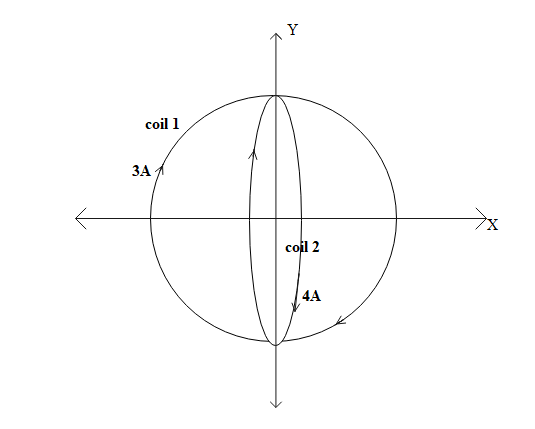Answer
384.6k+ views
Hint: We are given two concentric coils placed at right angles with each other which implies that the axis of both the coils and thus their respective magnetic fields must also be perpendicular to each other. Therefore, we shall find the magnetic fields due to both the coils individually and then find their resultant net value of magnetic induction at their centre.
Complete step by step solution:
The magnetic field, $B$ due to a circular coil is given as:
$B=\dfrac{{{\mu }_{0}}i}{2r}$
Where,
${{\mu }_{0}}=$ magnetic permeability constant and ${{\mu }_{0}}=4\pi \times {{10}^{-7}}\,Wb{{A}^{-1}}{{m}^{-1}}$
$i=$ current in the coil
$r=$ radius of coil

For coil 1, we have $i=3A$ and $r=2\pi cm$ or $r=2\pi \times {{10}^{-2}}m$,
Applying the above formula of magnetic field, we get
${{B}_{1}}=\dfrac{{{\mu }_{0}}\left( 3 \right)}{2\left( 2\pi \times {{10}^{-2}} \right)}$
Now, we shall put the value the magnetic permeability constant and then we get,
$\Rightarrow {{B}_{1}}=\dfrac{\left( 4\pi \times {{10}^{-7}} \right)\left( 3 \right)}{2\left( 2\pi \times {{10}^{-2}} \right)}$
Here, we cancel $4\pi $ and ${{10}^{-2}}$ from the numerator and denominator.
$\Rightarrow {{B}_{1}}=3\times {{10}^{-5}}$ ……………….. (1)
Similarly, for coil 2, we have $i=4A$ and $r=2\pi cm$ or $r=2\pi \times {{10}^{-2}}m$,
Applying the above formula of magnetic field, we get
${{B}_{2}}=\dfrac{{{\mu }_{0}}\left( 4 \right)}{2\left( 2\pi \times {{10}^{-2}} \right)}$
Now, we shall put the value the magnetic permeability constant and then we get,
$\Rightarrow {{B}_{2}}=\dfrac{\left( 4\pi \times {{10}^{-7}} \right)\left( 4 \right)}{2\left( 2\pi \times {{10}^{-2}} \right)}$
Here, we cancel $4\pi $ and ${{10}^{-2}}$ from the numerator and denominator.
$\Rightarrow {{B}_{2}}=4\times {{10}^{-5}}$ ………………. (2)
Now, we find the resultant net magnetic field using the formula $B=\sqrt{B_{1}^{2}+B_{2}^{2}}$.
Substituting the values of ${{B}_{1}}$ and ${{B}_{2}}$ from (1) and (2), we get
\[\Rightarrow B=\sqrt{{{\left( 3\times {{10}^{-5}} \right)}^{2}}+{{\left( 4\times {{10}^{-5}} \right)}^{2}}}\]
Taking ${{\left( {{10}^{-5}} \right)}^{2}}$ common and finding their square, we get
\[\begin{align}
& \Rightarrow B=\sqrt{{{\left( {{10}^{-5}} \right)}^{2}}\left( {{3}^{2}}+{{4}^{2}} \right)} \\
& \Rightarrow B={{10}^{-5}}\sqrt{{{3}^{2}}+{{4}^{2}}} \\
\end{align}\]
We know that ${{3}^{2}}=3\times 3=9$ and \[{{4}^{2}}=4\times 4=16\]. Thus, substituting these values and solving further.
$\begin{align}
& \Rightarrow B={{10}^{-5}}\sqrt{9+16} \\
& \Rightarrow B={{10}^{-5}}\sqrt{25} \\
& \Rightarrow B=5\times {{10}^{-5}} \\
\end{align}$
Therefore, the magnetic induction at centre is $5\times {{10}^{-5}}Wb{{m}^{-2}}$.
Hence, the correct option is (C) $5\times {{10}^{-5}}$.
Note:
The magnetic field is a vector quantity which has both magnitude and direction. Thus, the resultant of two or more magnetic field values is calculated by using rules of vector addition. Since, most of the quantities that we deal with in physics are vectors, therefore, one must have appropriate knowledge of vectors beforehand only.
Complete step by step solution:
The magnetic field, $B$ due to a circular coil is given as:
$B=\dfrac{{{\mu }_{0}}i}{2r}$
Where,
${{\mu }_{0}}=$ magnetic permeability constant and ${{\mu }_{0}}=4\pi \times {{10}^{-7}}\,Wb{{A}^{-1}}{{m}^{-1}}$
$i=$ current in the coil
$r=$ radius of coil

For coil 1, we have $i=3A$ and $r=2\pi cm$ or $r=2\pi \times {{10}^{-2}}m$,
Applying the above formula of magnetic field, we get
${{B}_{1}}=\dfrac{{{\mu }_{0}}\left( 3 \right)}{2\left( 2\pi \times {{10}^{-2}} \right)}$
Now, we shall put the value the magnetic permeability constant and then we get,
$\Rightarrow {{B}_{1}}=\dfrac{\left( 4\pi \times {{10}^{-7}} \right)\left( 3 \right)}{2\left( 2\pi \times {{10}^{-2}} \right)}$
Here, we cancel $4\pi $ and ${{10}^{-2}}$ from the numerator and denominator.
$\Rightarrow {{B}_{1}}=3\times {{10}^{-5}}$ ……………….. (1)
Similarly, for coil 2, we have $i=4A$ and $r=2\pi cm$ or $r=2\pi \times {{10}^{-2}}m$,
Applying the above formula of magnetic field, we get
${{B}_{2}}=\dfrac{{{\mu }_{0}}\left( 4 \right)}{2\left( 2\pi \times {{10}^{-2}} \right)}$
Now, we shall put the value the magnetic permeability constant and then we get,
$\Rightarrow {{B}_{2}}=\dfrac{\left( 4\pi \times {{10}^{-7}} \right)\left( 4 \right)}{2\left( 2\pi \times {{10}^{-2}} \right)}$
Here, we cancel $4\pi $ and ${{10}^{-2}}$ from the numerator and denominator.
$\Rightarrow {{B}_{2}}=4\times {{10}^{-5}}$ ………………. (2)
Now, we find the resultant net magnetic field using the formula $B=\sqrt{B_{1}^{2}+B_{2}^{2}}$.
Substituting the values of ${{B}_{1}}$ and ${{B}_{2}}$ from (1) and (2), we get
\[\Rightarrow B=\sqrt{{{\left( 3\times {{10}^{-5}} \right)}^{2}}+{{\left( 4\times {{10}^{-5}} \right)}^{2}}}\]
Taking ${{\left( {{10}^{-5}} \right)}^{2}}$ common and finding their square, we get
\[\begin{align}
& \Rightarrow B=\sqrt{{{\left( {{10}^{-5}} \right)}^{2}}\left( {{3}^{2}}+{{4}^{2}} \right)} \\
& \Rightarrow B={{10}^{-5}}\sqrt{{{3}^{2}}+{{4}^{2}}} \\
\end{align}\]
We know that ${{3}^{2}}=3\times 3=9$ and \[{{4}^{2}}=4\times 4=16\]. Thus, substituting these values and solving further.
$\begin{align}
& \Rightarrow B={{10}^{-5}}\sqrt{9+16} \\
& \Rightarrow B={{10}^{-5}}\sqrt{25} \\
& \Rightarrow B=5\times {{10}^{-5}} \\
\end{align}$
Therefore, the magnetic induction at centre is $5\times {{10}^{-5}}Wb{{m}^{-2}}$.
Hence, the correct option is (C) $5\times {{10}^{-5}}$.
Note:
The magnetic field is a vector quantity which has both magnitude and direction. Thus, the resultant of two or more magnetic field values is calculated by using rules of vector addition. Since, most of the quantities that we deal with in physics are vectors, therefore, one must have appropriate knowledge of vectors beforehand only.
Recently Updated Pages
How many sigma and pi bonds are present in HCequiv class 11 chemistry CBSE

Why Are Noble Gases NonReactive class 11 chemistry CBSE

Let X and Y be the sets of all positive divisors of class 11 maths CBSE

Let x and y be 2 real numbers which satisfy the equations class 11 maths CBSE

Let x 4log 2sqrt 9k 1 + 7 and y dfrac132log 2sqrt5 class 11 maths CBSE

Let x22ax+b20 and x22bx+a20 be two equations Then the class 11 maths CBSE

Trending doubts
Fill the blanks with the suitable prepositions 1 The class 9 english CBSE

At which age domestication of animals started A Neolithic class 11 social science CBSE

Which are the Top 10 Largest Countries of the World?

Give 10 examples for herbs , shrubs , climbers , creepers

Difference between Prokaryotic cell and Eukaryotic class 11 biology CBSE

Difference Between Plant Cell and Animal Cell

Write a letter to the principal requesting him to grant class 10 english CBSE

Change the following sentences into negative and interrogative class 10 english CBSE

Fill in the blanks A 1 lakh ten thousand B 1 million class 9 maths CBSE



